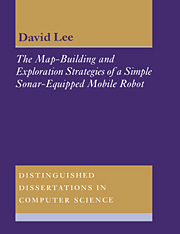 The Map-Building and Exploration Strategies of a Simple Sonar-Equipped Mobile Robot
The Map-Building and Exploration Strategies of a Simple Sonar-Equipped Mobile Robot Book contents
- Frontmatter
- Contents
- Preface
- 1 Question, Context and Method
- I Starting Points
- 2 Maps Used in Previous Research
- 3 The Maps Used in This Research
- 4 Approaches to Exploration
- II System Components
- III Experiments
- Appendix A The Feature-Map Data Structure
- Appendix B Test Rooms
- Appendix C Finding the Best-Fit Line
- Appendix D ARNE's Standard Dialogue
- Bibliography
- Index
2 - Maps Used in Previous Research
Published online by Cambridge University Press: 05 March 2012
- Frontmatter
- Contents
- Preface
- 1 Question, Context and Method
- I Starting Points
- 2 Maps Used in Previous Research
- 3 The Maps Used in This Research
- 4 Approaches to Exploration
- II System Components
- III Experiments
- Appendix A The Feature-Map Data Structure
- Appendix B Test Rooms
- Appendix C Finding the Best-Fit Line
- Appendix D ARNE's Standard Dialogue
- Bibliography
- Index
Summary
Map construction is an essential component of the research reported in this thesis. This chapter examines the reasons why a mobile robot might need a map and reviews the variety of types of world model which have been devised and implemented by previous researchers.
Early research work into mobile robots (Moravec 1983; Crowley 1985) took it as axiomatic that an effective mobile robot would need an environment model. The process of control was viewed as two steps: first the robot uses its sensors to build a world model and then it uses the world model to plan and execute its actions. The details could vary (different sensor modalities, different data structures for the world model) but the underlying two-step process was not questioned.
In the mid-1980's a number of researchers, most prominent among them being Rodney Brooks (1986), became frustrated with the perceived slow progress in mobile robotics and began to search for an alternative approach to the ‘traditional’ dependence on environment models. The intention was to minimise the processing between sensing and action. Robots were built in which there was an almost immediate link between the robot's sensors and its actuators. (Braitenberg's excellent book ‘Vehicles’ (1984) describes, in the form of thought experiments, what could be achieved by such robots.) The robots were able to perform tasks such as approaching beacons, avoiding obstacles, and following walls. These behaviours were found to be very robust. Brooks's robots could operate in unmodified office environments, sharing their world with unpredictable humans.
- Type
- Chapter
- Information
- The Map-Building and Exploration Strategies of a Simple Sonar-Equipped Mobile RobotAn Experimental, Quantitative Evaluation, pp. 13 - 26Publisher: Cambridge University PressPrint publication year: 1996
